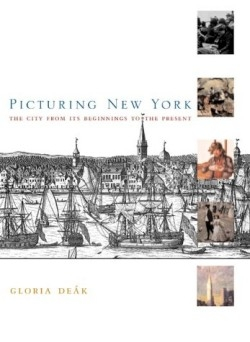Picturing New York
The City from Its Beginnings to Its Present
Deák’s experience as a writer and picture-researcher in her prize-winning Picturing America (1988) stands her in good stead to this sparkling appraisal of New York. An elegant combination of impressive illustration (including many double-spreads), perceptive text, and spacious format (91/8 x 107/8) gives this volume distinction. The author’s decision to tackle the city’s protean history—from origins to the present—in fourteen self-contained thematic essays enables her to escape the demands of the usual strictly chronological, all-inclusive narrative form. Instead, she offers the reader carefully focused excursions into significant areas of the city’s history, providing unmatched pictorial support for each essay. Sports, the arts, and religion get equal space with makers, shakers, and the masses. Deservedly, Brooklyn, the Bronx, Queens, and Staten Island receive generous recognition—and Broadway gets its own chapter.
Much to the reader’s benefit, Deák presents New York in a remarkably broad context. She explores the many sources of early New York’s human stock and the multiplicity of religions practiced (in relative freedom) under the city’s changing colonial rulers. She records the city’s exuberant life not only through local eyes, but also through those of a remarkable range of foreign visitors and observers. Among domestic sources, the reports and memoranda of early governors frequently feature, as do the agendas of civic and educational reformers and the always-rewarding diaries of those mid-nineteenth worthies, Philip Hone and George Templeton Strong, respectively a mayor and a leading lawyer. Writers as diverse as Jupiter Hammon, Walt Whitman, Edith Wharton, Herman Melville, Mark Twain, and F. Scott Fitzgerald are aptly quoted. In the foreign category, highly observant but lesser-known or neglected writers (M. Robert, Hamilton, La Rochefoucault-Liancourt, Moreau de St. Méry among them) rub shoulders with Sarah Knight, Fanny Kemble, Frances Trollope, Charles Dickens, and other memorable visitors.
The illustrations include every conceivable subject: maps, cityscapes, waterfronts, squares and streets, handbills, portraits, sports, sweatshops, factories, mansions, tenements, parks, gardens, prisons, civic events, entertainments, riots—the list is inexhaustible. All are topical and well chosen; all are well reproduced; many will be little known except to specialists. These illustrations more than merit the book’s cost.
Deák’s knowledge of historical and pictorial resources is daunting. Her delight in the highways and byways of New York’s history and her accomplished integration of text and illustration makes this volume a valuable complement to any other work on the city, including Wallace and Burrows’ highly acclaimed Gotham.
Disclosure: This article is not an endorsement, but a review. The publisher of this book provided free copies of the book to have their book reviewed by a professional reviewer. No fee was paid by the publisher for this review. Foreword Reviews only recommends books that we love. Foreword Magazine, Inc. is disclosing this in accordance with the Federal Trade Commission’s 16 CFR, Part 255.

